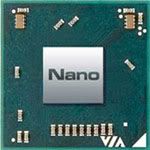
With netbooks becoming popular nowadays, the desktop counterpart (known as the nettop) is also coming out of the shadows. We have pre-built nettops offered by different companies, but for the DIY crowd and/or enthusiasts, building your own is usually more rewarding.
The most popular processor currently available is the Intel Atom 230. It features:
- 1.6GHz Clock frequency
- 533 Bus frequency
- 512KB L2 cache
- 1 core / 2 threads
- SSE3 SIMD instruction set
- 64-bit extensions
- 45nm manufacturing process
- 4 watts TDP
- 1.1125V Core voltage
You can get the Intel D945GCLF Mini-ITX mainboard that features the Atom 230.
Another Intel offering is the Atom 330 processor:
- dual-core version of the Atom 230
- 1.6GHz Clock / 533MHz Bus
- 2 x 512KB L2 cache
- 2 Cores / 4 threads
- 8W TDP
- 1.1625V Core voltage
If you'd want the Atom 330 processor, you can get it with the Intel D945GCLF2 mainboard.
Via also has a low-processor offering, which is the Via Nano L2100:
- 1.8GHz clock
- 800MHz Bus
- 1024KB L2 cache
- 1 core / 1 thread
- 65nm manufacturing process
- 25W TDP
- 1.2V Core voltage
Currently, I believe a production mainboard for the Via (Isaiah) Nano L2100 is not yet available, although it probably would be before the end of 2008.
X-bit Labs did a performance comparison of the three mentioned low-power processors:
"... Overall, we can say that highly integrated solutions from Intel and VIA that never consume over 70W of power and offer pretty sufficient performance for a wide range of tasks a home user would ever need to work with. New generation of low-power platforms not only work with Internet applications in Windows Vista OS, but are also powerful enough for more resource-demanding tasks, such as office applications and HD video playback (with a few limitations)." [X-bit Labs | The Battle of Low-Power Processors: Best Choice for a Nettop ]
Choosing the right processor will definitely depend on your priorities. The Atom 230 is the one to choose for low cost and low power consumption. Performance-per-watt would go to the Atom 330, but the Via Nano is also looking good with its 1.8GHz clock, 1024KB L2 cache, dual DDR2 support, and 800MHz bus.
Mini-ITX cases are available, and usually come with a 180W or so PSU. Do check what the form-factors of HDD (2.5 or 3.5) and ODD (regular or slim-type) the case accepts. You don't want to be stuck with a 3.5" hard drive, only to find out that the case you bought only accepts a mobile 2.5" HDD.
You can also use a micro-ATX case, or even a regular ATX case if you wish. This could be a workaround if the mini-ITX cases that you find cannot accomodate a 3.5" HDD, or a full size optical drive. The trade off, however, is a bigger case footprint, when compared to a mini-ITX case.
Possible uses for a nettop:
- simple web browsing and document-editing PC
- standalone BitTorrent PC
- file backup server
- NAS
Though the primary use for a nettop PC would probably be a secondary low-power consumption PC for web browsing and simple document editing, you can use it for your own specific purpose. Happy building!



2 comments:
I'd also say a nettop could be a handy HTPC.
Post a Comment